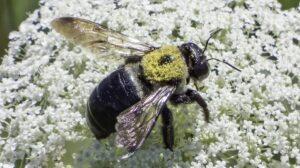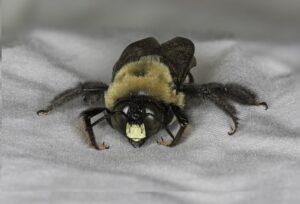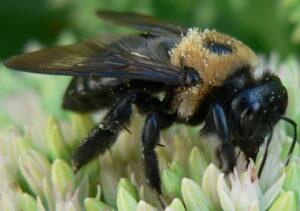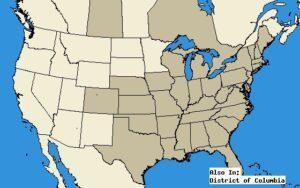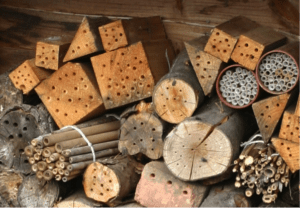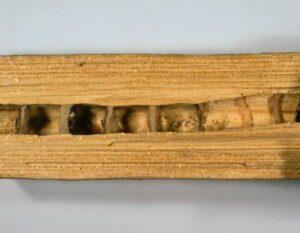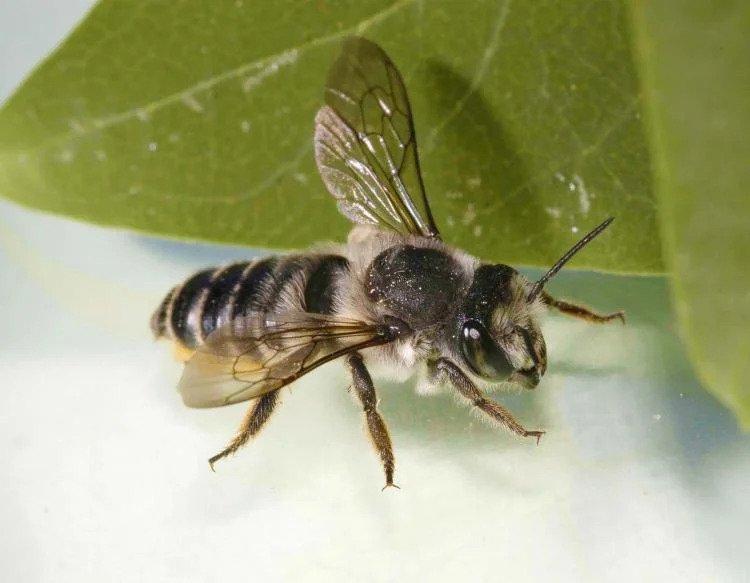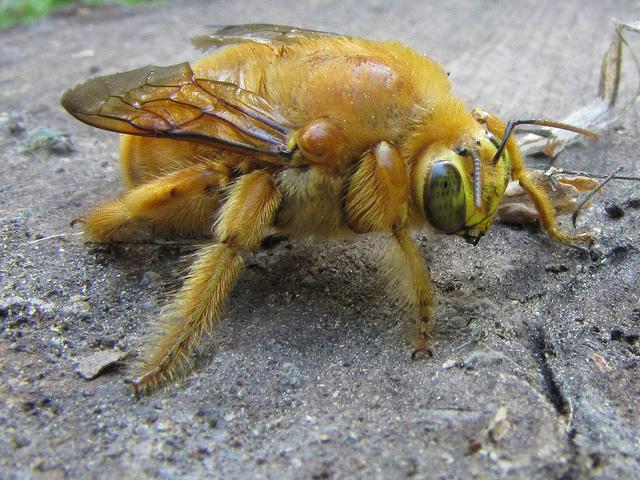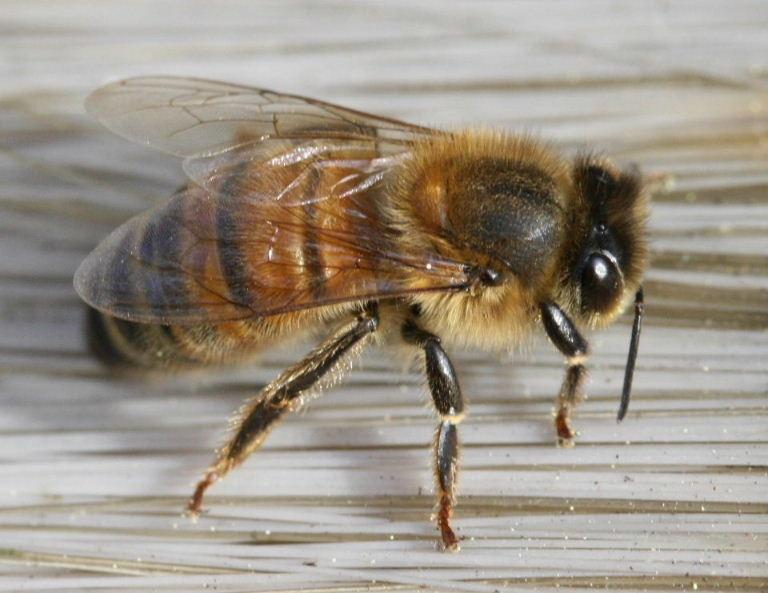Eastern Carpenter Bee (Xylocopa virginica)
Updated on
17/11/2022The eastern carpenter bee, replicating a bumblebee in size and color, is indigenous to parts of the United States, mainly inhabiting the southern, central, and eastern corners. These bees are creators and destroyers at the same time. On the one hand, they are effective pollinators for flower crops, vegetables, and fruits. On the other hand, they drill a hole into woods to build nests, significantly deteriorating the wood’s quality. This species has three subspecies: X. v. krombeini, X. v. texana, and X. v. virginica.
Scientific Classification
- Class:Insecta
- Order:Hymenoptera
- Family:Apidae
- Genus:Xylocopa
- Species:X. virginica
Conservation Status
Description
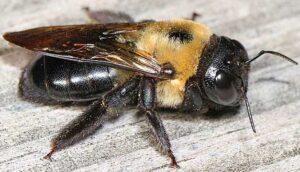
Due to their similarity with the bumblebee, they are often mistaken for the latter. Yet, the eastern carpenter bee has a glossier body and shiny abdomens, as opposed to the hairy abdomen of the bumblebee. They mostly appear black, often marked with a purplish tint. These are moderately large bees, ranging from 19 mm to 25 mm.
Male vs. Females
Though the males and females of this species are similar in body mass, they exhibit sexual dimorphism in certain aspects. The male eastern carpenter bee has a longer body than its female counterparts. Contrastingly, the head of the females appears wider.
The difference is also visible in terms of color. One could distinguish the males of this species by the white spot on the face, whereas the face is entirely black for females.
Both sexes have sharp maxillae or wedge-shaped mouthparts, helping them quickly draw nectar from the flowers.
Distribution: Throughout North America, mainly in the central, southern, and eastern parts stretching to parts of the Rocky Mountains, far north up to Nebraska, Maine, and the Canadian province of Ontario
Habitat: Coniferous woods like pine, cypress, or cedar, logs, and stumps of dead trees
Do They Bite/Sting: Females have a stinger and can sting; however, they will do so only if provoked or handled inappropriately
Lifespan: Solitary Bees: One year; Social Bees: Three years
Predators: Birds like shrikes, and woodpeckers; bee-eating mammals like honey badgers
Behavior and Characteristics
Social system – Role of females and males
The eastern carpenter bee has a unique social system since they aren’t entirely solitary or wholly social. The female does most of the chores and even cares for or tends to her sisters in the nest. They would mostly live as solitary bees when nesting materials are available in plenty, with a reproductive female residing in each of the solitary nests.
In the case of a communal nest, the females are designated with three distinct roles – name primary, secondary, and tertiary.
In a primary group, the females take complete charge of the nest, from reproduction to laying eggs and supplying food to larvae.
In the secondary group, the females are not as active as those in the primary setup. They may participate in oviposition, maintain the nest, and care for the larva. The tertiary females are the most inactive, depending on the primary bees. The primary females overwinter twice, while the secondary and tertiary females overwinter just once.
In a social nest, the work gets divided between the younger and older females. The older bees in the primary group do most of the work, from excavating and lining the cells to collecting food. The younger population mostly stays within the nest guarding its entrance.
The males fly or hover outside the nest, protecting their domain from intruders or seeking a mater. The males exhibit territorial behavior establishing their domains near the nest entrances and protecting their colonies. They stay in a single territory for around two weeks post which they shift to another location. They often take short breaks during the day and make it a point to deal firmly with those intruders who have taken advantage of their absence.
Flight behavior
The flights involving protecting a territory are short, lasting only a few minutes. However, sometimes it could exceed an hour. The male eastern carpenter bees would barely react to other bees flying unless the latter came at an increased speed.
Diet and Feeding
The adult eastern carpenter bees primarily feed on pollen nectar. They adapt the technique of nectar robbing, common in several bee species. With the help of their maxillae or mouthparts, they go deep into the corolla of flowers to access the nectaries. They have glands on their abdomen that helps in depositing a scent in the flower they have collected nectar. In this way, they are discouraged from going to the same flower the next time.
Nesting
They are real carpenters in building their nests, which have resulted in their names. The female eastern carpenter bee takes charge of constructing their dwelling places. She does this by chewing a round hole in the wood of dead stumps, logs, or trees using her powerful mandibles. The female would create tunnels and chambers within the hole to house her young. The walls separating each chamber are made using the shavings. They can excavate one inch of a long tunnel daily, chewing around 15mm of wood daily.
Life Cycle
Each nest comprises a single mated individual, with mating occurring in April. In fact, during this time, gestures like a bobbing dance involving several males and a few females are mainly observed. The males would need their mate to fly before mating, and the two would then face and hover over each other.
Upon coming in contact, the male mounts on the female’s back, trying to push his abdomen over hers. If the female lands during copulation, the male stops the process, waiting for his mate to fly again.
1. Egg Stage
The females lay the eggs in summer, mainly in July, that hatch in seven to ten days. Their maturity occurs in a reverse manner. The eggs laid last mature first and vice versa. This reduces the chances of accidents and damage to the immature siblings as the mature species wouldn’t have to crawl over them to move.
2. Larva Stage
The larvae have a white body and get their food from the primary females within the nest. The larval development gets completed by August or mid-September.
3. Pupa Stage
The pupae stay in their cells until they are around 22 days old.
4. Adult Stage
The juveniles can fly within four days after their emergence; however, they do not go out that soon. They remain within their nests for another 2-3 weeks, mostly guarding the entrance. The adult females either live in a solitary nest or a social nest.
Getting Rid of Eastern Carpenter Bees
To prevent these bees from damaging the wooden structures spraying insecticides in the surroundings would help.
FAQs
Yes, they contribute to the environment by being pollinators of flowering plants and crops.
Source
squarespace-cdn.com, backyardnature.net, i.pinimg.com, bugguide.net, education.mdc.mo.gov




